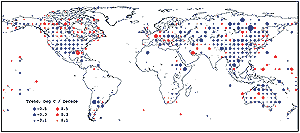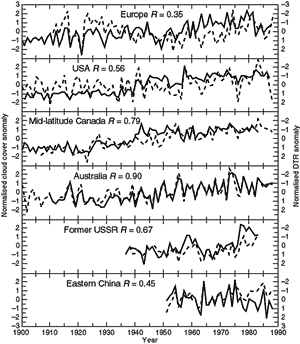Continued from previous page

Figure. 2.2: Trends in annual diurnal temperature range (DTR, °C/decade),
from 1950 to 1993, for non-urban stations only, updated from Easterling
et al. (1997). Decreases are in blue and increases in red. This data set
of maximum and minimum temperature differs from and has more restricted
coverage than those of mean temperature used elsewhere in Section
2.2. |

Figure 2.3: Cloud cover (solid line) and DTR (°C, dashed line)
for Europe, USA, Canada, Australia, the former Soviet Union, and eastern
China (from Dai et al., 1997a). Note that the axis for DTR has been inverted.
Therefore, a positive correlation of cloud cover with inverted DTR indicates
a negative cloud cover/DTR correlation. |
Since the DTR is the maximum temperature minus the minimum temperature, the
DTR can decrease when the trend in the maximum or minimum temperature is downward,
upward, or unchanging. This contributes to less spatial coherence on the DTR
map than on maps of mean temperature trend. Maximum temperatures have increased
over most areas with the notable exception of eastern Canada, the southern United
States, portions of Eastern and southern Europe (Brunetti et al., 2000a), southern
China, and parts of southern South America. Minimum temperatures, however, increased
almost everywhere except in eastern Canada and small areas of Eastern Europe
and the Middle East. The DTR decreased in most areas, except over middle Canada,
and parts of southern Africa, south-west Asia, Europe, and the western tropical
Pacific Islands. In some areas the pattern of temperature change has been different.
In both New Zealand (Salinger, 1995) and central Europe (Weber et al., 1994;
Brázdil et al., 1996) maximum and minimum temperatures have increased
at similar rates. In India the DTR has increased due to a decrease in the minimum
temperature (Kumar et al., 1994). Eastern Canada also shows a slight increase
in DTR (Easterling et al., 1997). However, recently annual mean maximum and
minimum temperatures for Canada have been analysed using newly homogenised data
(Vincent, 1998; Vincent and Gullet, 1999); these have increased by 0.3 and 0.4°C,
respectively, over the last fifty years (Zhang et al., 1999). Central England
temperature also shows no decrease in DTR since 1878 (Parker and Horton, 1999).
Similarly, a new temperature data set for north-east Spain (not available on
Figure 2.2 below, Brunet-India et al., 1999a,b),
shows an increase in maximum temperature over 1913 to 1998 to be about twice
as fast as that of minimum temperature. Recent analyses by Quintana-Gomez (1999)
reveal a large reduction in the DTR over Venezuela and Colombia, primarily due
to increasing minimum temperatures (up to 0.5°C/decade). In northern China,
the decrease in DTR is due to a stronger warming in minimum temperature compared
with maximum temperatures. However, in southern China the decreased DTR is due
to a cooling in maximum with a slight warming in minimum temperature (Zhai and
Ren, 1999).
The DTR is particularly susceptible to urban effects. Gallo et al. (1996) examined
differences in DTR between stations based on predominant land use in the vicinity
of the observing site. Results show statistically significant differences in
DTR between stations associated with predominantly rural land use/land cover
and those associated with more urban land use/land cover, with rural settings
generally having larger DTR than urban settings. Although this shows that the
distinction between urban and rural land use is important as one of the factors
that can influence the trends observed in temperatures, Figure
2.2 shows annual mean trends in diurnal temperature range in worldwide non-urban
stations over the period 1950 to 1993 (from Easterling et al., 1997). The trends
for both the maximum and minimum temperatures are about 0.005°C/decade smaller
than the trends for the full network including urban sites, which is consistent
with earlier estimated urban effects on global temperature anomaly time-series
(Jones et al., 1990).
Minimum temperature for both hemispheres increased abruptly in the late 1970s,
coincident with an apparent change in the character of the El Niño-Southern
Oscillation (ENSO) phenomenon, giving persistently warmer sea temperatures in
the tropical central and east Pacific (see Section
2.6.2). Seasonally, the strongest changes in the DTR were in the boreal
winter (-0.13°C/decade for rural stations) and the smallest changes were
during boreal summer (-0.065°C/decade), indicating some seasonality in the
changes. Preliminary extensions of the Easterling et al. (1997) analysis to
1997 show that the declining trends in DTR have continued in much of North America
and Asia.
Figure 2.3 shows the relationship between
cloudiness and the DTR for a number of regions where long-term cloud cover data
are available (Dai et al., 1997a). For each region there was an increase in
cloud cover over the 20th century and generally a decrease in DTR. In some instances
the correlation between annual cloud cover and annual DTR is remarkably strong,
suggesting a distinct relationship between cloud cover and DTR. This would be
expected since cloud dampens the diurnal cycle of radiation balance at the surface.
Anthropogenically-caused increases in tropospheric aerosol loadings have been
implicated in some of these cloud cover changes, while the aerosols themselves
can cause small changes in DTR without cloud changes (Hansen et al., 1998 and
Chapter 6).

